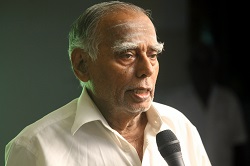
An archaeologist, historian, art historian, epigraphist and expert in both Sanskrit and Tamil classical literature, Dr Nagaswamy has contributed to those disciplines since the 1950s. He was the founder-Director of the Tamil Nadu Archaeology Department and Vice chancellor, Kanchipuram University. He authored numerous books, among them Art and culture of Tamil Nadu, Tantric Cult in Tamil Nadu, The sensuous and the sacred: Chola bronzes from South India (co-authored), Art and religion of the Bhairavas, Mahabalipuram, Uttaramerur, Roman Karur, Vedic Roots of Hindu Iconography, Masterpieces of Chola Art, Thirukkural: An Abridgement of Sastras, Mirror of Tamil and Sanskrit, Tamil Nadu: the Land of Vedas.
Dr Nagaswamy widely popularized archaeology, epigraphy and classical arts in Tamil Nadu, authoring in particular books for children, and founded the now famous Chidambaram Natyanjali Festival. He appeared as an expert witness in the famous London Nataraja case, in which he made a convincing case in the London High Court for the theft of the Nataraja statue, which was subsequently returned to India.
Dr Nagaswamy is the recipient of numerous awards, including the Kalaimamani (awarded by the Government of Tamil Nadu) and the Padma Bhushan (2018).
Abstracts of the lectures:
Interface of Sangam Literature and Sanskrit
This first lecture will explore the earliest extant Tamil literature: the collection called Sangam poems. “Sangam” in Tamil refers to an assembly of scholars/poets who gathered when new poetry was presented for assessment to be awarded classical status.
According to tradition there were three such assemblies , but all the available Tamil poems belong to the last Sangam. There are 2500 poems altogether, sung by over 200 poets, of whom nearly 60 poets and more bore Sanskrit names like Bharadvaja, Gautama, Valmiki, Damodara, Kapila and so on.
These poems are compiled into two major groups as eight anthologies and ten long poems, and further grouped into two other divisions as aham and puram poems, based on their content: aham poems deal with śringāra or love between man and woman in different situations; this includes some 2100 poems, which use poetic imageries intended for aesthetic enjoyment, either to be heard as songs or witnessed in dance performance.
Puram poems deal with kings, chieftains and women, historical characters whose qualities, heroism, faiths, rituals, liberality, conquests, rulership, etc. are described in poetic beauty. They were also sung and performed by singers and dancers in their assembly or in public. Kings are shown performing Vedic sacrifices more often than temple worship, and following the fourfold varṇāśrama, including brahmacārya, married life, forest dwelling and sanyāsa, and the four puruṣārtha: dharma, artha, kāma and mokṣa as their life motive. Of the three dynasties praised in the poems, the Cheras were said to be the descendants of Yādāva Krishna, the Cholas those of Ikshvaku/Rāma, while the Pāndyas claimed descent from Arjuna; they came from northern India and settled to rule the Tamil country. According to Tamil tradition, many chieftains also came with sage Agastya, who taught them Sanskrit and Tamil and contributed to Tamil grammar, poetry, music, dance, and religious philosophy.
Nāṭyaśāstra and Tamil Literature
The Sanskrit text Nāṭyaśāstra is a great scientific treatise, not only on dance but also on poetry, embellishment of poetry, costumes, construction of theatre, the aesthetics of enjoyment, music, musical instruments, etc. It discusses the use of Sanskrit, Prakrit, and also regional languages. In music and dialogue, it extends to the whole of Bhāratvarṣa and beyond to Southeast Asia. It is further divided into mārgi and desi (classical and folk) and defines aesthetic enjoyment according to the Rasa theory. The Nāṭyaśāstra seems to be a very early text as its echoes are found in Rāmāyana and Mahābhārata; Tamil commentators mention sage Agastya as its composer, and his influence on Tamil literature from very early times.
The early grammatical text Tolkāppiyam, composed by Tolkāppiyam, a disciple of Agastya, consists of aphorisms called sūtram, as Panini’s are called Sūtras. Its three divisions or adhikārams — ezhuttu adhikāram, col ādhikaram and porul adhikāram — follow a Sanskrit pattern and use technical terms that are direct translations or adaptations of Sanskrit technical terms; the fivefold division of landscape, for instance, is drawn from concepts spelled out in Nāṭyaśāstra, and the deities associated with these five types of landscape are Vedic and Puranic (Indra, Varuna, Krishna, Kumāra, and Durgā); similarly, Tolkāppiyam’s chapter on meypādu (bodily response) is an exact rendering of rasa adhyāya of Nāṭyaśāstra.Indeed, my study shows that Tolkāppiyam is a Tamil rendering of Nāṭyaśāstra.
The lecture will also show how Silappadikāram, a dramatic kāvya of supreme importance, authored by a Chera prince, is a nātaka kāppiyam.